Augmenting Satellite Remote Sensing with AERONET-OC for Plume Monitoring in the Chesapeake Bay
Abstract
1. Introduction
2. Materials and Methods
2.1. AERONET-OC Data
2.2. Satellite Data
2.3. Comparisons of Satellite and AERONET-OC Rrs
2.4. Susquehanna River USGS Stream Gauge TSM
2.5. Satellite and AERONET-OC Sensor TSM
2.6. Air-Quality Observations
3. Results and Discussion
3.1. Multispectral Comparisons
3.2. Hyperspectral Comparisons
3.3. Sediment Plume Monitoring
3.4. Smoke Plume Monitoring
4. Discussion
4.1. Multi- and Hyperspectral Comparisons
4.2. Plume Monitoring
5. Conclusions
Author Contributions
Funding
Data Availability Statement
Acknowledgments
Conflicts of Interest
Abbreviations
| AERONET | Aerosol Robotic Network |
| AERONET-OC | Ocean Color component of AERONET |
| NASA | National Aeronautics and Space Administration |
| NOAA | National Oceanic and Atmospheric Administration |
| USGS | United States Geological Survey |
| EPA | Environmental Protection Agency |
| TSM | Total suspended matter |
| NCCOS | NOAA CoastWatch National Centers for Coastal Ocean Science |
| AOD | Aerosol optical depth |
| AQI | Air-quality index |
| MAIAC | Multi-Angle Implementation of Atmospheric Correction |
| MODIS | Moderate Resolution Imaging Spectroradiometer |
| VIIRS | Visible Infrared Imaging Radiometer Suite |
| OLCI-S3A/B | Ocean and Land Colour Instrument, Sentinel-3A/B |
| PACE-OCI | Plankton, Aerosol, Cloud, ocean Ecosystem—Ocean Color Instrument |
| nLw | Normalized water-leaving radiance |
| Rrs | Remote sensing reflectance |
| OB.DAAC | Ocean Biology Processing Group Distributed Active Archive Center |
References
- Maryland State Archives: Maryland at a Glance, Chesapeake Bay. Available online: https://msa.maryland.gov/msa/mdmanual/01glance/html/ches.html (accessed on 29 April 2025).
- Wolny, J.L.; Tomlinson, M.C.; Schollaert Uz, S.; Egerton, T.A.; McKay, J.R.; Murasko, S.; Wickes, L.; Scott, G.P.; Place, A.R. Current and Future Remote Sensing of Harmful Algal Blooms in the Chesapeake Bay to Support the Shellfish Industry. Front. Mar. Sci. 2020, 7, 337. [Google Scholar] [CrossRef]
- National Oceanic and Atmospheric Administration (NOAA) CoastWatch: National Centers for Coastal Ocean Science (NCCOS). Available online: https://coastwatch.noaa.gov/cw_html/NCCOS.html (accessed on 25 February 2025).
- Chesapeake Bay Program: Monitoring Programs. Available online: https://www.chesapeakebay.net/what/programs/monitoring (accessed on 4 February 2025).
- Turner, J.; Carl, F.; Friedrichs, M. Long-Term Trends in Chesapeake Bay Remote Sensing Reflectance: Implications for Water Clarity. J. Geophys. Res. Ocean. 2021, 126, e2021JC017959. [Google Scholar] [CrossRef]
- D’Sa, E.J.; Tzortziou, M.; Liu, B. Extreme events and impacts on organic carbon cycles from ocean color remote sensing: Review with case study, challenges, and future directions. Earth-Sci. Rev. 2023, 243, 104503. [Google Scholar] [CrossRef]
- St. Laurent, K.A.; Coles, V.J.; Hood, R.R. Climate Extremes and Variability Surrounding Chesapeake Bay: Past, Present, and Future. J. Am. Water Resour. Assoc. 2022, 58, 826–854. [Google Scholar] [CrossRef]
- Ding, H.; Elmore, A.J. Spatio-temporal patterns in water surface temperature from Landsat time series data in the Chesapeake Bay, U.S.A. Remote Sens. Environ. 2015, 168, 335–348. [Google Scholar] [CrossRef]
- Zibordi, G.; Holben, B.; Hooker, S.; Mélin, F.; Berthon, J.F.; Slutsker, I.; Giles, D.; Vandemark, D.; Feng, H.; Rutledge, K.; et al. A network for standardized ocean color validation measurements. EOS Trans. Am. Geophys. Union 2006, 87, 293–297. [Google Scholar] [CrossRef]
- Ishizaka, J.; Yang, M.; Fujii, N.; Katano, T.; Hori, M.; Mine, T.; Saitoh, K.; Murakami, H. Use of AERONET-OC for validation of SGLI/GCOM-C products in Ariake Sea, Japan. J. Oceanogr. 2022, 78, 291–309. [Google Scholar] [CrossRef]
- Melin, F. Validation of ocean color remote sensing reflectance data: Analysis of results at European coastal sites. Remote Sens. Environ. 2022, 280, 113153. [Google Scholar] [CrossRef]
- Zibordi, G.; Holben, B.N.; Talone, M.; D’Alimonte, D.; Slutsker, I.; Giles, D.M.; Sorokin, M.G. Advances in the ocean color component of the aerosol robotic network (AERONET-OC). J. Atmos. Ocean. Technol. 2021, 38, 725–746. [Google Scholar] [CrossRef]
- Jamet, C.; Loisel, H.; Kuchinke, C.; Ruddick, K.; Zibordi, G.; Feng, H. Comparison of three SeaWiFS Atmospheric Correction Algorithms for Turbid Waters using AERONET-OC Measurements. Remote Sens. Environ. 2011, 115, 1955–1965. [Google Scholar] [CrossRef]
- Maryland Department of the Environment: Air Quality Forecast. Available online: https://mde.maryland.gov/programs/Air/AirQualityMonitoring/Pages/AQForecast.aspx (accessed on 2 April 2025).
- Maryland Department of the Environment. 2023 Seasonal Air Quality Report: Fine Particulate Matter (PM2.5). 2023. Available online: https://mde.maryland.gov/programs/air/AirQualityMonitoring/Documents/SeasonalReports/SeasonalReport_2023PM.pdf (accessed on 17 January 2025).
- Holben, B.N.; Eck, T.F.; Slutsker, I.; Tanré, D.; Buis, J.P.; Setzer, A.; Vermote, E.; Reagan, J.A.; Kaufman, Y.J.; Nakajima, T.; et al. AERONET—A Federated Instrument Network and Data Archive for Aerosol Characterization. Remote Sens. Environ. 1998, 66, 1–16. [Google Scholar] [CrossRef]
- Chesapeake Bay Foundation, State of the Bay Report: About the Indicators. Available online: https://www.cbf.org/about-the-bay/state-of-the-bay-report/sotb-about-the-indicators.html (accessed on 25 February 2025).
- Chesapeake Progress: Water Quality Standards Attainment and Monitoring. Available online: https://www.chesapeakeprogress.com/clean-water/water-quality (accessed on 30 January 2025).
- Chesapeake Bay Program: The Impact of Susquehanna Sediments on the Chesapeake Bay. 2000. Available online: https://www.chesapeake.org/stac/Pubs/Sediment_Report.pdf (accessed on 4 April 2025).
- Ondrusek, M.; Stengel, E.; Kinkade, C.S.; Vogel, R.L.; Keegstra, P.; Hunter, C.; Kim, C. The development of a new optical total suspended matter algorithm for the Chesapeake Bay. Remote Sens. Environ. 2012, 119, 243–254. [Google Scholar] [CrossRef]
- Ma, Z.; Zhao, Y.; Zhao, W.; Feng, J.; Liu, Y.; Tsou, J.Y.; Zhang, Y. Estimating Total Suspended Matter and Analyzing Influencing Factors in the Pearl River Estuary (China). J. Marine Sci. Eng. 2024, 12, 167. [Google Scholar] [CrossRef]
- Özşeker, K.; Seyhan, K.; Dürrani, Ö.; Atasaral, Ş.; Şahin, A. Investigating the seasonal and spatial dynamics of total suspended matter composition in major fishing ports across the southeastern Black Sea. Regional Studies Marine Sci. 2024, 77, 103610. [Google Scholar] [CrossRef]
- Jay, D.A.; Talke, S.A.; Hudson, A.; Twardowski, M. Estuarine turbidity maxima revisited: Instrumental approaches, remote sensing, modeling studies, and new directions. Dev. Sedimentol. 2015, 68, 49–109. [Google Scholar] [CrossRef]
- Botrel, M.; Maranger, R. Global historical trends and drivers of submerged aquatic vegetation quantities in lakes. Water Res. 2023, 29, 242. [Google Scholar] [CrossRef]
- Lee, D.Y.; Keller, D.; Crump, B.; Hood, R. Community metabolism and energy transfer in the Chesapeake Bay estuarine turbidity maximum. Marine Ecol. Prog. Ser. 2012, 449, 65–82. [Google Scholar] [CrossRef]
- Chesapeake Bay Program: Underwater Grasses in the Chesapeake Bay Continue Upward Climb. 2024. Available online: https://www.chesapeakebay.net/news/pressrelease/underwater-grasses-in-the-chesapeake-bay-continue-upward-climb (accessed on 30 January 2025).
- NASA Goddard Space Flight Center; Ocean Ecology Laboratory; Ocean Biology Processing Group. Moderate-resolution Imaging Spectroradiometer (MODIS) Aqua Level-2 Ocean Color (OC), Version 2022. Available online: https://oceancolor.gsfc.nasa.gov/data/10.5067/AQUA/MODIS/L2/OC/2022 (accessed on 13 May 2025).
- NASA Goddard Space Flight Center; Ocean Ecology Laboratory; Ocean Biology Processing Group. Visible and Infrared Imager/Radiometer Suite (VIIRS) Level-2 Regional Ocean Color (OC) Data, Version 2022.0. Available online: https://oceancolor.gsfc.nasa.gov/data/10.5067/NOAA-21/VIIRS/L2/OC/2022 (accessed on 13 May 2025).
- NASA Goddard Space Flight Center; Ocean Ecology Laboratory; Ocean Biology Processing Group. Ocean and Land Colour Imager (OLCI) Level-2 Earth Observation Full Resolution Ocean Color, Version 2022. Available online: https://oceancolor.gsfc.nasa.gov/data/10.5067/SENTINEL-3A/OLCI/L2/EFR/OC/2022 (accessed on 13 May 2025).
- NASA Goddard Space Flight Center; Ocean Ecology Laboratory; Ocean Biology Processing Group Distributed Active Archive Center. Available online: https://oceancolor.gsfc.nasa.gov/data/overview/ (accessed on 2 April 2025).
- NASA Goddard Space Flight Center; Ocean Ecology Laboratory; Ocean Biology Processing Group. Ocean Color Instrument Level-2 Ocean Color Apparent Optical Properties (OC_AOP), Version 3.0. Available online: https://oceancolor.gsfc.nasa.gov/data/10.5067/PACE/OCI/L2/OC_AOP/3.0 (accessed on 13 May 2025).
- Ibrahim, A.; Franz, B.; Bailey, S.; Werdell, J.; Ahmad, Z.; Mobley, C. NASA Earthdata Algorithm Publication Tool (APT), Version 1.2. Remote Sensing Reflectance. NASA: Washington, DC, USA, 2024. [CrossRef]
- Bailey, S.W.; Werdell, P.J. A multi-sensor approach for the on-orbit validation of ocean color satellite data products. Remote Sens. Environ. 2006, 102, 12–23. [Google Scholar] [CrossRef]
- Qin, P.; Simis, S.G.H.; Tilstone, G.H. Radiometric validation of atmospheric correction for MERIS in the Baltic Sea based on continuous observations from ships and AERONET-OC. Remote Sens. Environ. 2017, 200, 263–280. [Google Scholar] [CrossRef]
- Runkel, R.L.; Crawford, C.G.; Cohn, T.A. Load Estimator (LOADEST): A FORTRAN program for estimating constituent loads in streams and rivers. In USGS Techniques and Methods Book 4; USGS (United States Geological Survey): Reston, VA, USA, 2004. [Google Scholar] [CrossRef]
- Clark, J.B.; Schollaert Uz, S. Toward the future integration of land-to-ocean observing systems to characterize organic carbon fluxes from storms. Estuar. Coast. Shelf Sci. 2024, 302, 108694. [Google Scholar] [CrossRef]
- van der Woerd, H.J.; Wernand, M.R. True Colour Classification of Natural Waters with Medium-Spectral Resolution Satellites: SeaWiFS, MODIS, MERIS and OLCI. Sensors 2015, 15, 25663–25680. [Google Scholar] [CrossRef] [PubMed]
- IOCCG. Remote Sensing of Inherent Optical Properties: Fundamentals, Tests of Algorithms, and Applications; Lee, Z.-P., Ed.; Reports of the International Ocean-Colour Coordinating Group; IOCCG: Dartmouth, NS, Canada, 2006. [Google Scholar]
- Lyapustin, A.; Wang, Y.; Korkin, S.; Huang, D. MODIS Collection 6 MAIAC algorithm. Atmos. Meas. Tech. 2018, 11, 5741–5765. [Google Scholar] [CrossRef]
- AERONET’s Version 2.0 Quality Assurance Criteria. Available online: https://aeronet.gsfc.nasa.gov/new_web/PDF/AERONETcriteria_final1.pdf (accessed on 2 April 2025).
- Wei, J.; Yu, X.; Lee, Z.; Wang, M.; Jiang, L. Improving low-quality satellite remote sensing reflectance at blue bands over coastal and inland waters. Remote Sens. Environ. 2020, 250, 112029. [Google Scholar] [CrossRef]
- Werdell, P.J.; Franz, B.; Poulin, C.; Allen, J.; Cairns, B.; Caplan, S.; Cetinić, I.; Craig, S.; Gao, M.; Hasekamp, O.; et al. Life After Launch: A Snapshot of the First 6 Months of NASA’s Plankton, Aerosol, Cloud, Ocean Ecosystem (PACE) Mission. 2024. Available online: https://ntrs.nasa.gov/api/citations/20240011486/downloads/werdell_SPIE2024_final2.pdf (accessed on 2 April 2025).
- Nash, J.E.; Sutcliffe, J.V. River flow forecasting through conceptual models part I—A discussion of principles. J. Hydrol. 1970, 10, 282–290. [Google Scholar] [CrossRef]
- Natural Resources Canada: Interactions with the Atmosphere. Available online: https://natural-resources.canada.ca/maps-tools-publications/satellite-elevation-air-photos/interactions-atmosphere (accessed on 3 March 2025).
- Lefevre, F.; Chalifour, A.; Yu, L.; Chodavarapu, V.; Juneau, P.; Izquierdo, R. Algal fluorescence sensor integrated into a microfluidic chip for water pollutant detection. Lab Chip 2011, 12, 787–793. [Google Scholar] [CrossRef]
- Vos, W.; Donze, M.; Buiteveld, H. On the reflectance spectrum of algae in water: The nature of the peak at 700 nm and its shift with varying concentration. In Communications on Sanitary Engineering Water Management; Delft University of Technology: Delft, The Netherlands, 1986; pp. 86–122. [Google Scholar]
- Dorji, P.; Fearns, P.; Broomhall, M. A Semi-Analytic Model for Estimating Total Suspended Sediment Concentration in Turbid Coastal Waters of Northern Western Australia Using MODIS-Aqua 250 m Data. Remote Sens. 2016, 8, 556. [Google Scholar] [CrossRef]
- Gurbisz, C.; Kemp, W.M.; Sanford, L.P.; Orth, R.J. Mechanisms of storm-related loss and resilience in a large submersed plant bed. Estuar. Coast. 2016, 39, 951–966. [Google Scholar] [CrossRef]
- Schollaert Uz, S.; Amez, T.J.; Clark, J.B.; Smith, S.L. DEEP-VIEW Integration of Coastal Observations and Models to Inform Water Quality Resource Managers and Decisions. In Proceedings of the IGARSS 2024—2024 IEEE International Geoscience and Remote Sensing Symposium, Athens, Greece, 7–12 July 2024. [Google Scholar] [CrossRef]
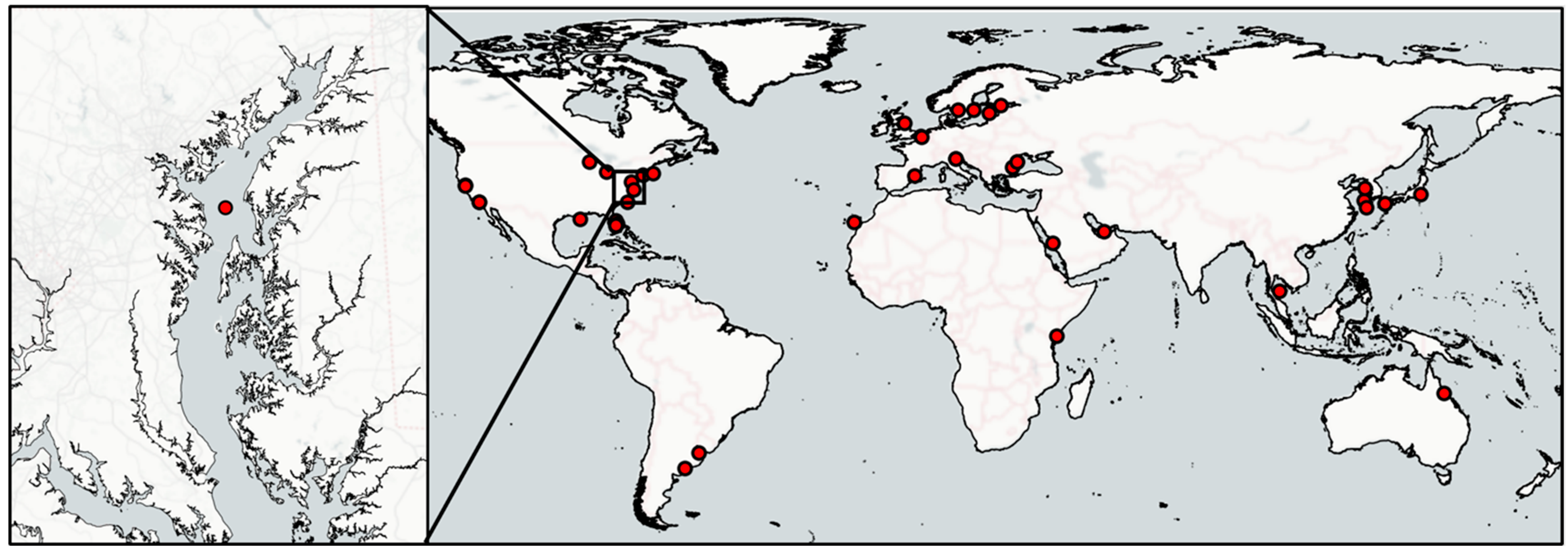
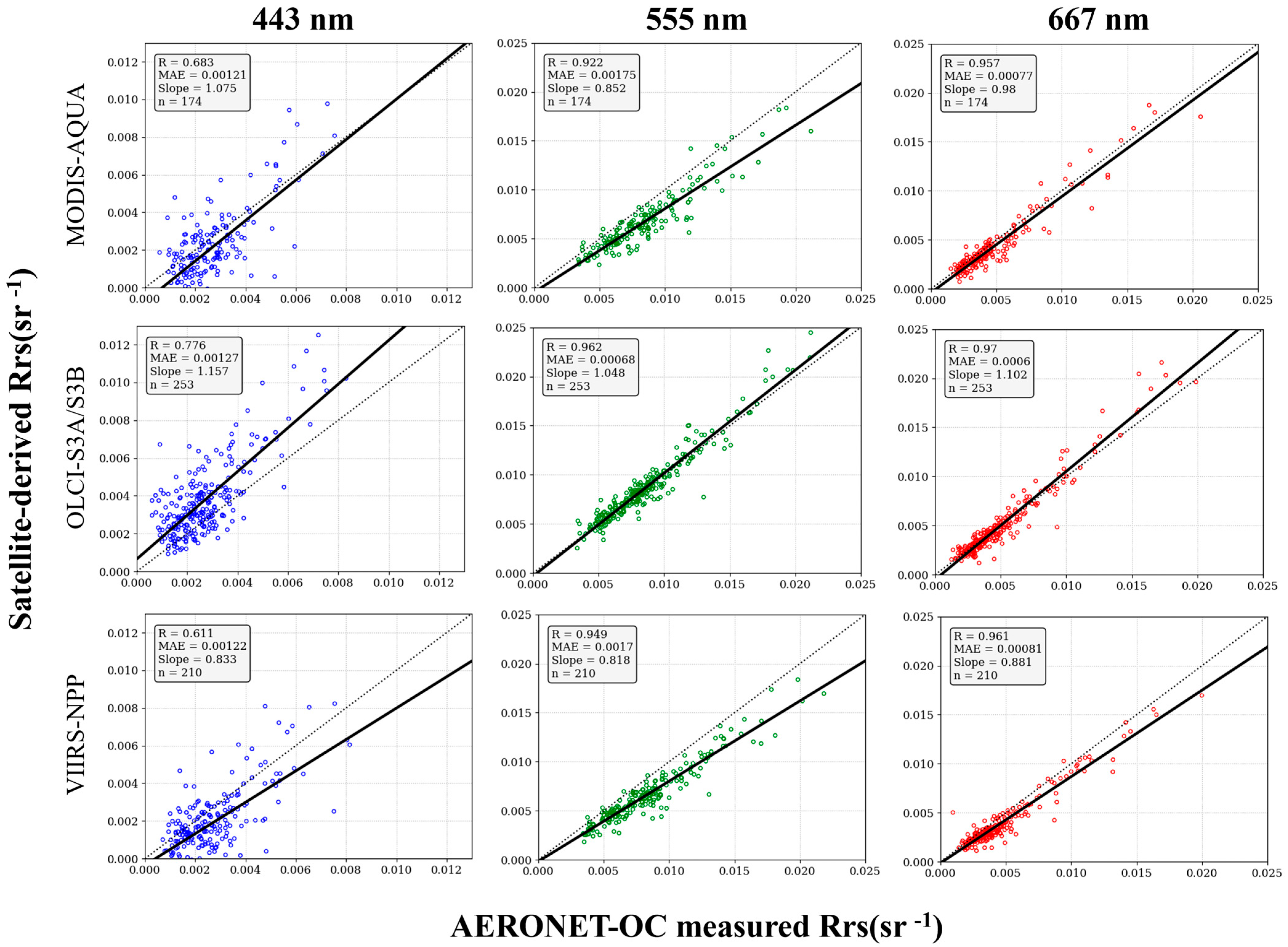
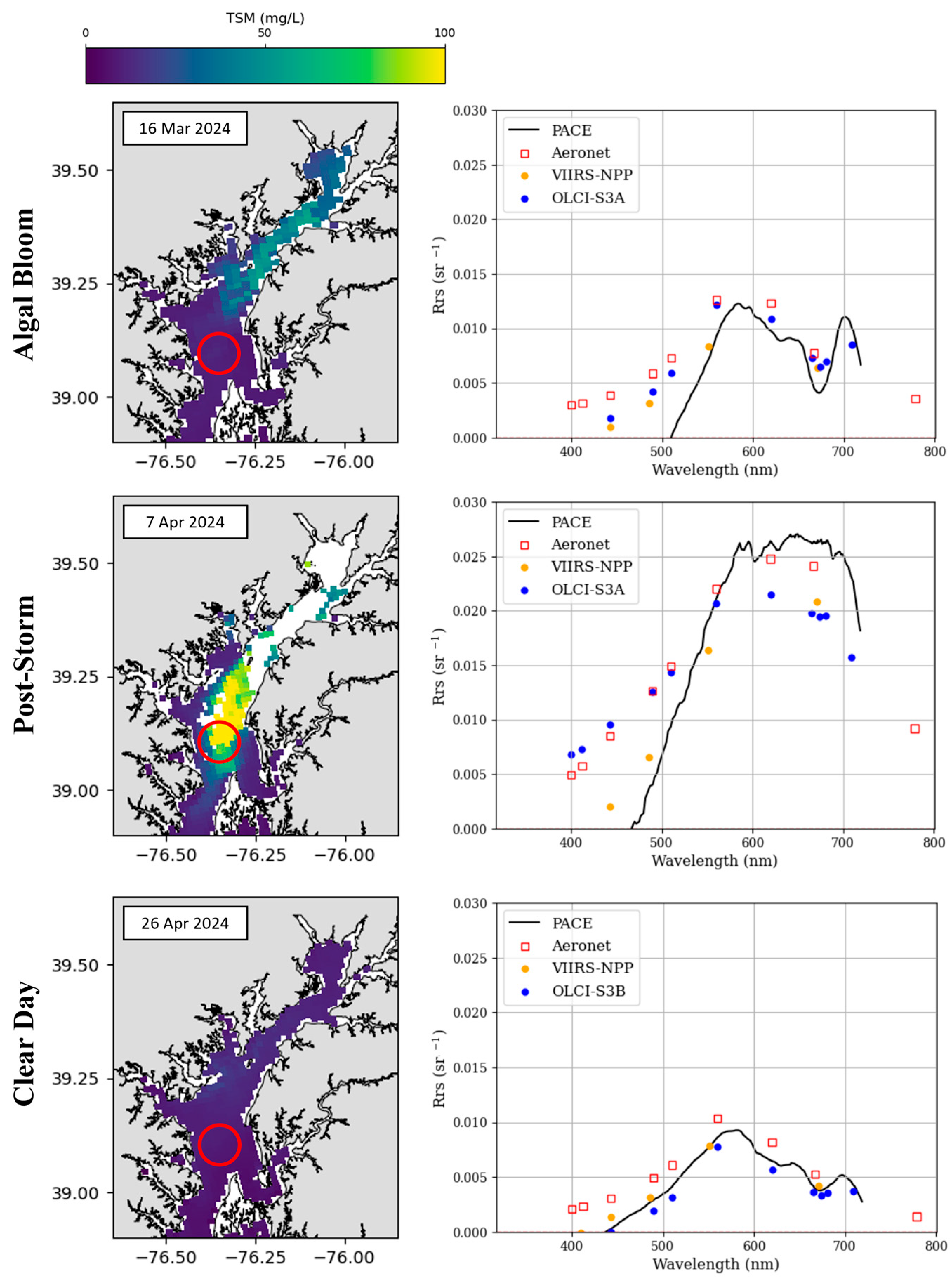
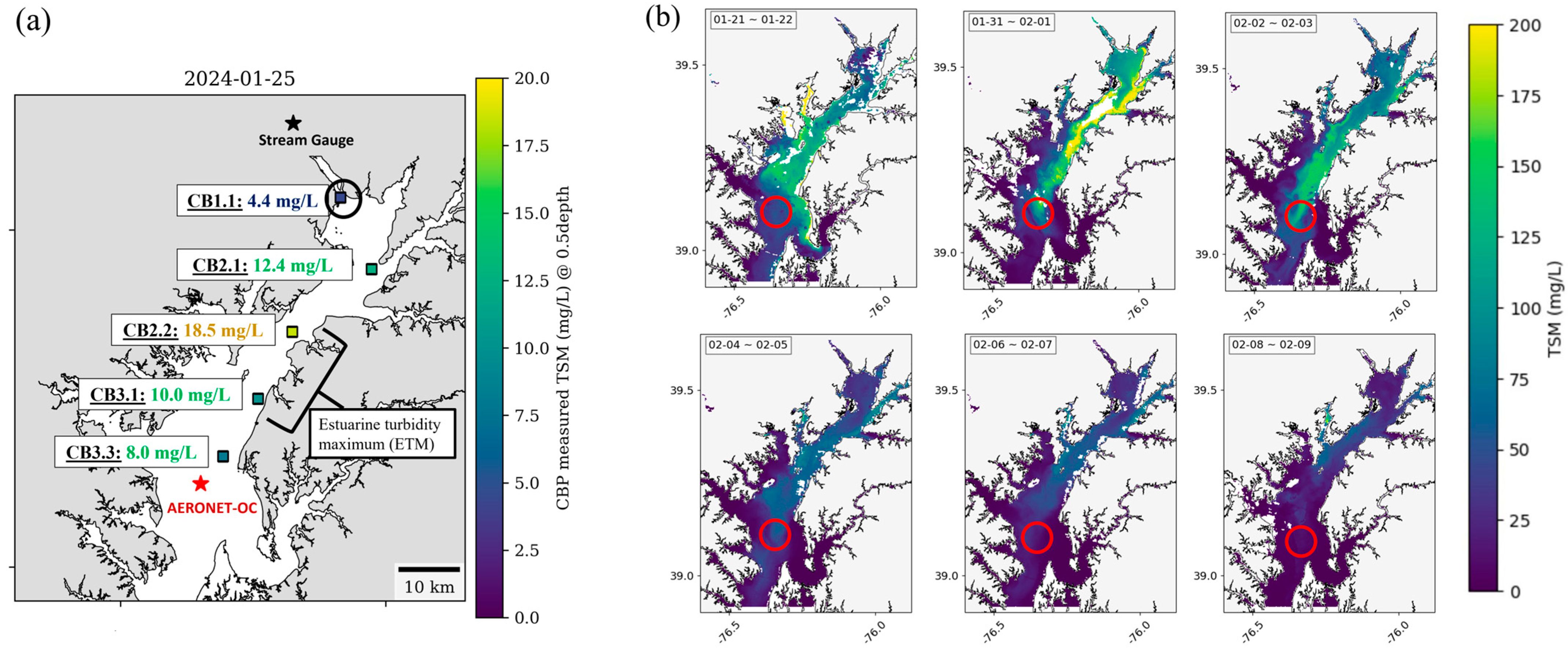

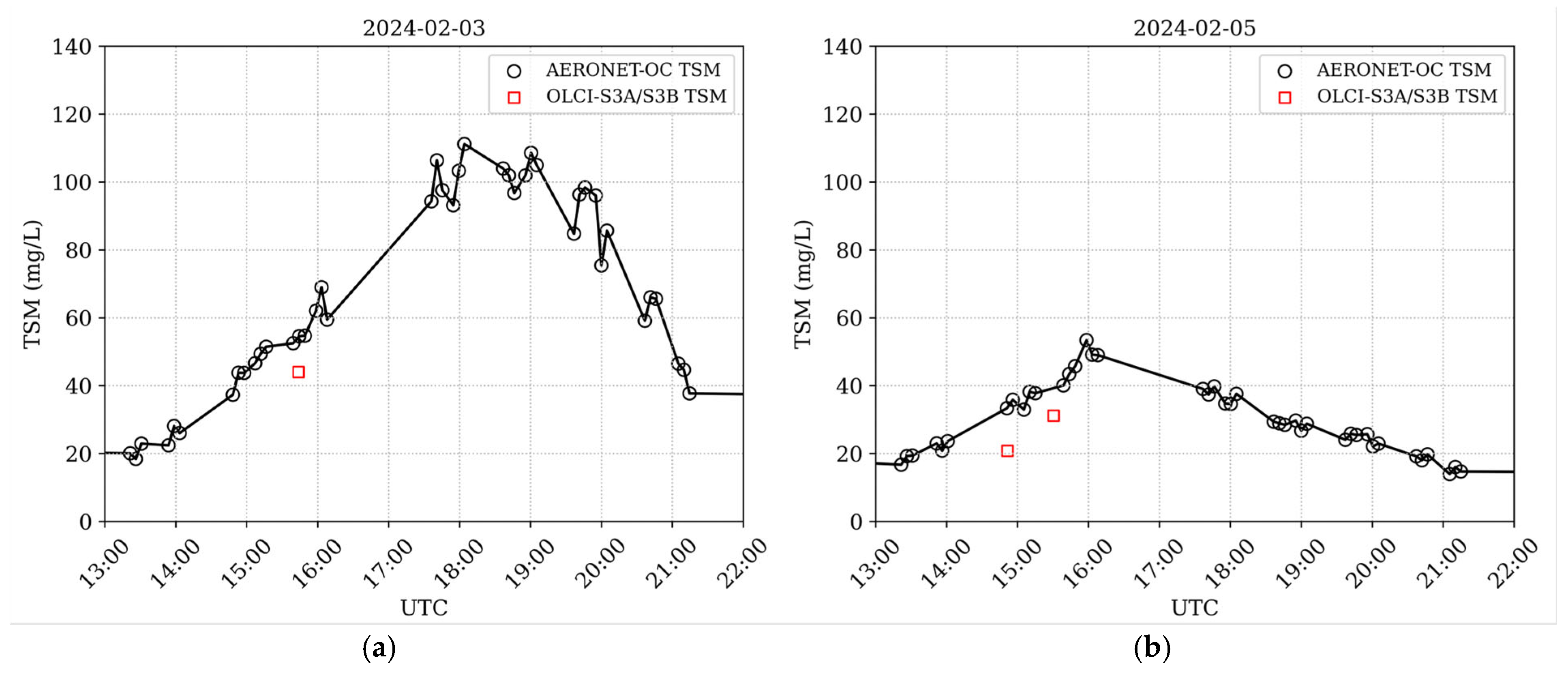


| Sensor | λ (nm) | N | Bias (sr−1) | MAE (sr−1) | RMSE (sr−1) | R |
|---|---|---|---|---|---|---|
| MODIS-Aqua | 667 | 174 | −0.00048 | 0.00077 | 0.00105 | 0.95718 |
| 555 | 174 | −0.00168 | 0.00175 | 0.00209 | 0.92166 | |
| 443 | 174 | −0.00054 | 0.00121 | 0.00162 | 0.68267 | |
| OLCI-S3A/S3B | 665 | 253 | 0.00001 | 0.00060 | 0.00095 | 0.96968 |
| 560 | 253 | 0.00010 | 0.00068 | 0.00099 | 0.96244 | |
| 443 | 253 | 0.00108 | 0.00127 | 0.00168 | 0.77561 | |
| VIIRS-NPP | 671 | 210 | −0.00069 | 0.00081 | 0.00109 | 0.96113 |
| 551 | 210 | −0.00168 | 0.00170 | 0.00202 | 0.94928 | |
| 443 | 210 | −0.00079 | 0.00122 | 0.00171 | 0.61145 |
Disclaimer/Publisher’s Note: The statements, opinions and data contained in all publications are solely those of the individual author(s) and contributor(s) and not of MDPI and/or the editor(s). MDPI and/or the editor(s) disclaim responsibility for any injury to people or property resulting from any ideas, methods, instructions or products referred to in the content. |
© 2025 by the authors. Licensee MDPI, Basel, Switzerland. This article is an open access article distributed under the terms and conditions of the Creative Commons Attribution (CC BY) license (https://creativecommons.org/licenses/by/4.0/).
Share and Cite
Smith, S.L.; Schollaert Uz, S.; Clark, J.B.; Aurin, D. Augmenting Satellite Remote Sensing with AERONET-OC for Plume Monitoring in the Chesapeake Bay. Remote Sens. 2025, 17, 1767. https://doi.org/10.3390/rs17101767
Smith SL, Schollaert Uz S, Clark JB, Aurin D. Augmenting Satellite Remote Sensing with AERONET-OC for Plume Monitoring in the Chesapeake Bay. Remote Sensing. 2025; 17(10):1767. https://doi.org/10.3390/rs17101767
Chicago/Turabian StyleSmith, Samantha Lynn, Stephanie Schollaert Uz, J. Blake Clark, and Dirk Aurin. 2025. "Augmenting Satellite Remote Sensing with AERONET-OC for Plume Monitoring in the Chesapeake Bay" Remote Sensing 17, no. 10: 1767. https://doi.org/10.3390/rs17101767
APA StyleSmith, S. L., Schollaert Uz, S., Clark, J. B., & Aurin, D. (2025). Augmenting Satellite Remote Sensing with AERONET-OC for Plume Monitoring in the Chesapeake Bay. Remote Sensing, 17(10), 1767. https://doi.org/10.3390/rs17101767





